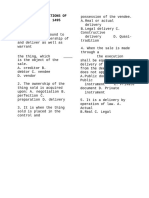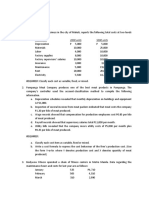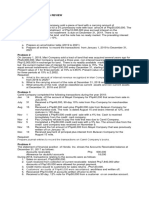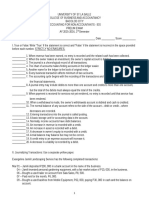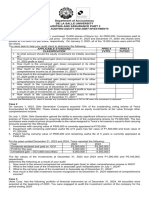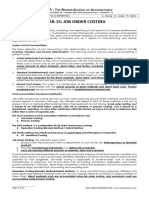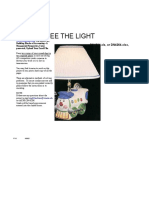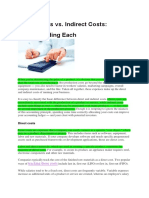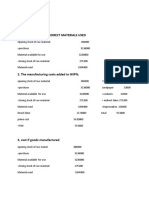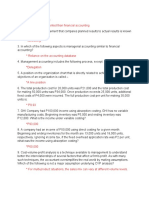AFAR 15 Job Order Costing
AFAR 15 Job Order Costing
Uploaded by
Trisha Marie BuendichoCopyright:
Available Formats
AFAR 15 Job Order Costing
AFAR 15 Job Order Costing
Uploaded by
Trisha Marie BuendichoOriginal Title
Copyright
Available Formats
Share this document
Did you find this document useful?
Is this content inappropriate?
Copyright:
Available Formats
AFAR 15 Job Order Costing
AFAR 15 Job Order Costing
Uploaded by
Trisha Marie BuendichoCopyright:
Available Formats
ReSA - THE REVIEW SCHOOL OF ACCOUNTANCY
CPA Review Batch 45 May 2023 CPA Licensure Examination
AFAR-15
ADVANCED FINANCIAL ACCOUNTING & REPORTING (AFAR) A. DAYAG A. CRUZ
COST ACCOUNTING – JOB ORDER COSTING
Definition
Cost Accounting refers to recording, classifying, and reporting all cost aspects of company performance
during a particular period of time. It is therefore, a system that records, summarizes, analyzes, and interprets
the details of the cost of materials, labor and overhead necessary to produce and sell an article or a
product. Cost accounting is usually considered only as it applies to manufacturing and service
organizations as well.
System of Cost Accumulation
The basic objective of cost accounting is the determination or accumulation of a product’s cost for
inventory valuation and income determination. The following systems may be used in accumulating a
product’s cost:
1. Actual (Historical) Cost System. Under this system, direct materials, direct labor, and factory overhead
costs are determined as they occur simultaneously with the manufacturing operation but the total of
these costs is known only as the operation has been completed. An actual cost system collects the
actual amounts of direct materials, direct labor, and factory overhead that are incurred for each
product.
2. Standard (Predetermined) Cost System. Under this system, costs are determined in advance from
analysis and forecasts made before the actual production begins. In a standard cost system, standard
unit costs are computed for the direct materials, direct labor, and factory overhead; these amounts
rather than the actual costs are carried to Finished Goods.
3. Normal Cost System. This system is a combination of the actual cost system and the standard cost
system. It accumulates only the actual amounts of direct materials and direct labor costs. Factory
overhead costs are accumulated on the basis of predetermined overhead rate.
Cost Accumulation Procedures (Methods)
Job order and process costing are the two most widely used cost accumulation methods, and they have
several aspects in common. Although, the ultimate cost object in both of these methods is the unit of
product, the two methods differ fundamentally in their approach to cost tracing. In job order costing, cost
is traced to an individual batch, specific units, lot or contract. In process costing, cost is traced to a
department, operation, or some other subdivision within the factory as long a it involves a continuous flow
rather than a series of separate jobs.
The most common cost accumulation methods or procedures are:
1. Job Order Costing
2. Process Costing
The third method, is a combination of job order and process costing,
3. Operation Costing/Blended Method / Hybrid Method
The fourth method was introduced because of Just-In-Time (JIT) Philosophy in Production,
4. JIT - Backflush Costing
Job Order Costing. This method is used when:
1. products are manufactured within a department or cost center are heterogeneous or dissimilar
products.
2. they are manufactured individually or in distinct lots or batches,
3. each job requiring different amounts of materials, labor and overhead.
Costs should be recorded separately for every job produced. Keeping of individual records is possible only
if the various inputs to a job can be easily identified. Detailed cost record must be kept for each job and
updated as work progresses. Job-order costing is applicable to made-to-order work in factories,
manufacturers of expensive, one of kind items such as building contractors, shipbuilders, and motion
picture companies, workshops, repair shops, job printers, construction engineers, and service business such
as medical, legal, architectural, accounting and consulting firms.
Operation Costing/Blended Method/Hybrid Method/. In some manufacturing companies, different units
have significantly different materials costs, but all units undergo identical conversion in large quantities. In
these cases, direct materials costs are accumulated using job order costing, and conversion costs are
accumulated using process costing.
Page 1 of 11 0915-2303213 www.resacpareview.com
ReSA – THE REVIEW SCHOOL OF ACCOUNTANCY
JOB ORDER COSTING AFAR-15
I – Actual and Normal Costing
For fiscal year 2021, Matz Solution it would incur total overhead costs of P1,200,000 and work
40,000 machine hours. During January 2021, the company works exclusively on one job, Job #458.
It incurred January costs as follows:
Direct materials usage………………………………… P 121,000
Direct labor (1,400 hours)……………………… 30,800
Manufacturing overhead:
Rent………………………………………………………………… P 11,200
Utilities…………………………………………………… 15,200
Insurance…………………………………………………… 32,100
Labor……………………………………………………………… 15,500
Depreciation…………………………………………… 23,700
Maintenance……………………………………………… 10,800
Total OH……………………………………………………… 108,500
Total Manufacturing Costs…………………………… P 260,300
Machine hours worked in January: 3,400.
1. Assuming the company uses an actual cost system, compute the January costs assigned to
Job#458.
A. P253,800 C. P260,300
B. P251,800 D. P265,000
2. Assuming the company uses a normal cost system, compute the January costs assigned to Job#458.
A. P253,800 C. P260,300
B. P251,800 D. P265,000
Disposition of Over-under applied Overhead Account
When factory overhead is over-under applied and a variance or difference results, either of the
following methods is acceptable to account for the difference in closing the account (this is
in accordance with the Cost Accounting Standards Board requirement):
1. If difference is insignificant (immaterial) to Cost of Goods Sold or Income Summary. The
over-or under applied factory overhead may be debited or credited to Cost of Goods Sold
(most common treatment or most convenient) or Income Summary. This has no effect on unit
cost and treats the entire variance as a PERIOD EXPENSE.
2. If difference is significant (material) to Cost of Goods Sold and Inventories. The over-
under applied factory overhead may be debited or credited to Cost of Goods Sold and Ending
Inventories (Work-in-Process and Finished Goods). This would change cost per unit.
II – Disposition of Over-under applied Overhead Account
The records of XYZ Co. revealed the following data for 2021:
Work in Process P 73,150
Finished Goods 115,000
Cost of Goods Sold 133,650
Direct Labor 111,600
Direct Material 84,200
1. Refer to XYZ Co. Assume, for this question only, actual overhead is P98,700 and applied
overhead is P93,250. Manufacturing Overhead is
a. Overapplied by P12,900.
b. underapplied by P18,350.
c. overapplied by P5,450.
d. underapplied by P5,450.
2. Refer to XYZ Co. Assume that XYZ has underapplied overhead of P37,200 for 2019 and that
this amount is material. What journal entry is needed to close the Overhead account? (Round
decimals to nearest whole percent.)
a. Debit Work in Process P8,456; Finished Goods P13,294; Cost of Goods Sold
P15,450 and credit Overhead P37,200
b. Debit Overhead P37,200 and credit Work in Process P8,456; Finished Goods
P13,294; Cost of Goods Sold P15,450
c. Debit Work in Process P37,200 and credit Overhead P37,200
d. Debit Cost of Goods Sold P37,200 and credit Overhead P37,200
3. Refer to XYZ Co. Assume that XYZ has underapplied overhead of P10,000 for 2019 and that
this amount is immaterial. What is the balance in Cost of Goods Sold after the underapplied
overhead is closed?
a. P133,650 c. P143,650
b. P123,650 d. P137,803
4. Refer to XYZ Co. Assume that XYZ has overapplied overhead of P25,000 for 2019 and that this
amount is material. What is the balance in Cost of Goods Sold after the overapplied
overhead is closed?
a. P123,267 c. P158,650
b. P144,033 d. P108,650
Page 2 of 11 0915-2303213 www.resacpareview.com
ReSA – THE REVIEW SCHOOL OF ACCOUNTANCY
JOB ORDER COSTING AFAR-15
III – Job Order Costs Sheets
The Usry Company uses a job order costing system which is based on normal costs, and overhead
is applied on machine hours. The inventories on October 1: direct materials, P2,000, finished
goods, P5,000 (Job Order No. 1000), work-in-process, Job Order No. 1001, the job had been
assigned P130 for direct materials, P165 for direct labor cost with 100 machine hours. Purchases
of direct materials, 30,000 pieces @ P1.40 per piece. Following are the additional costs incurred
during the month.
Direct Direct Machine
Job Order Nos. Materials Labor Cost Hours
1001 P 4,100 P 1,375 1,300
1002 9,150 7,250 3,700
1003 11,275 14,325 8,200
1004 3,225 2,800 1,500
1005 6,500 6,100 3,200
1006 2,750 1,650 980
Manufacturing overhead costs are charged to jobs on the basis of P1.50 per machine hour used.
The actual manufacturing overhead cost for the month totaled P30,350. During October, Job Order
Nos. 1001, 1002, 1004, and 1005 were completed. Jobs 1001 and 1002 were shipped out and the
customers were billed for P9,000 for Job No. 1001 and P20,000 for 1002.
1. The cost of goods manufactured amounted to:
A. P55,495 B. P55,500 C. P56,495 D. P57,500
2. The work-in-process on October 31 amounted to:
A. P25,675 B. P29,820 C. P43,770 D. P69,445
3. The cost of goods available for sale amounted to:
A. P55,495 B. P60,495 C. P60,500 D. P61,495
4. The finished goods on October 31 amounted to:
A. P 8,275 B. P17,400 C. P 30,675 D. P43,770
5. The cost of goods of goods sold amounted to:
A. P29,820 B. P29,375 C. P21,950 D. P7,870
6. The gross margins on Jobs 1001 and 1002 amounted to:
Job 1001 Job 1002 Job 1001 Job 1002
A. P1,200 P 1,850 C. P1,150 P1,850
B. 1,130 ( 1,950) D. 1,130 (1,850)
7. The direct materials on October 31 amounted to:
A. P 5,000 B. P 7,000 C. P 30,675 D. P43,770
IV – Manufacturing Cost Computations
The following account balances and other information for Barfield Company pertain to November
operations:
Account Balances
November 1 November 30
Finished goods P 70,000 P 60,000
Work in process 50,000 ?
Raw materials inventory 10,000 25,000
Accounts payable ? 15,000
Accrued payroll 10,000 20,000
Accumulated depreciation – factory equipment 80,000 90,000
Other information:
a. The company’s Raw Materials Inventory account contains both direct and indirect materials,
materials purchased on account during November, P105,000. Direct materials issued to
production cost P80,000.
b. Barfield Company applies factory overhead at a predetermined rate of P3 per direct
labor hour.
c. During November, direct labor employees worked 25,000 hours at a rate of P4 per hour.
d. Jobs 385, 386, and 387 were still in process at the end of November. A total of P5,000
of direct materials has been charged to these three jobs. To date, 5,000 direct labor
hours have been worked on these jobs.
e. The accrued payroll account is used for factory employees only. Assuming no payroll
deductions, payment to factory employees during the month totaled P140,000.
f. Factory overhead was underapplied by P5,000.
g. Payments on account totaled P55,000.
Required: Determine the following -
1. Direct materials charged to operations
2. Indirect materials
3. Factory overhead applied during the month
4. Ending inventory of work in process
5. Cost of goods manufactured
6. Cost of goods sold before over-under applied
7. Indirect labor
8. Miscellaneous factory overhead
9. Accounts payable, November 1
Page 3 of 11 0915-2303213 www.resacpareview.com
ReSA – THE REVIEW SCHOOL OF ACCOUNTANCY
JOB ORDER COSTING AFAR-15
V
Adams Co. uses a job order costing system and the following information is available from its
records. The company has 3 jobs in process: #5, #8, and #12.
Raw material used P120,000
Direct labor per hour P8.50
Overhead applied based on direct labor cost 120%
Direct material was requisitioned as follows for each job respectively: 30 percent, 25 percent,
and 25 percent; the balance of the requisitions was considered indirect. Direct labor hours per
job are 2,500; 3,100; and 4,200; respectively. Indirect labor is P33,000. Other actual overhead
costs totaled P36,000.
1. Refer to Adams Co. What is the prime cost of Job #5?
A. P42,250 C. P73,250
B. P57,250 D. P82,750
2. Refer to Adams Co. What is the total amount of overhead applied to Job #8?
A. P18,250 C. P30,000
B. P26,350 D. P31,620
3. Refer to Adams Co. What is the total amount of actual overhead?
A. P36,000 C. P93,000
B. P69,000 D. P99,960
4. Refer to Adams Co. How much overhead is applied to Work in Process?
A. P69,000 C. P132,960
B. P99,960 D. P144,000
5. Refer to Adams Co. If Job #12 is completed and transferred, what is the balance in Work in
Process Inventory at the end of the period if overhead is applied at the end of the period?
A. P96,700 C. P170,720
B. P99,020 D. P139,540
6. Refer to Adams Co. Assume the balance in Work in Process Inventory was P18,500 on June 1 and
P25,297 on June 30. The balance on June 30 represents one job that contains direct material
of P11,250. How many direct labor hours have been worked on this job (rounded to the nearest
hour)?
A. 751 C. 1,653
B. 1,324 D. 2,976
VI
Brooke Corporation manufactures rattan furniture sets for export and uses job order cost system
in accounting for its costs. You obtained from the corporation’s books and records the following
information for the year ended December 31, 2021:
• The work-in-process inventory on January 1 was 20% less than the work-in-process inventory
on December 31.
• The total manufacturing costs added during 2019 was P900,000 based on actual direct
materials and direct labor but with manufacturing overhead applied on actual direct labor
pesos.
• The manufacturing overhead applied to process was 72% of the direct labor pesos, and it
was equal to 25% of the total manufacturing costs.
• The cost of goods manufactured, also based on actual direct materials, actual direct labor
and applied manufacturing overhead was P850,000.
The cost of direct materials used and the work-in-process inventory on December 31, 2021:
Direct Materials Work-In-Process
Used Inventory
A. P1,075,000 P200,000
B. P 362,500 P250,000
C. P 312,500 P250,000
D. P 312,500 P275,000
VII
Fusion Company has the following data on April 30, 2021:
April manufacturing overhead…………………………………………………… P30,101.80
Decrease in ending inventories:
Materials……………………………………………………………………………………………… 2,430.00
Goods in process…………………………………………………………………………… 590.00
Increase in ending inventory:
Finished goods………………………………………………………………………………… 1,320.40
The manufacturing overhead amounts to 50% of the direct labor and the direct labor and
manufacturing overhead combined equal 50% of the total costs of manufacturing. All materials are
purchased FOB shipping point. What is the costs of goods manufactured?
A. P180,610.80 C. P182,300.80
B. P181,200.80 D. P183,200.80
Page 4 of 11 0915-2303213 www.resacpareview.com
ReSA – THE REVIEW SCHOOL OF ACCOUNTANCY
JOB ORDER COSTING AFAR-15
VIII – Normal Costing
Normal operating capacity of Warren, Inc. is 150,000 machine hours per month, the level used to
compute the predetermined factory overhead application rate. At this level of activity, fixed
factory overhead is estimated to be P300,000, and variable factory overhead is estimated to be
P150,000. During March, actual production required 140,000 machine hours, and the actual factory
overhead totaled P435,000.
Required:
1. Determine the fixed portion of the fixed factory overhead application rate.
2. Determine the variable portion of the factory overhead application rate.
3. Is factory overhead for March over- or underapplied and by how much?
4. How much is the spending variance, and is it favorable or unfavorable?
5. How much is the idle capacity variance, and is it favorable or unfavorable?
IX – Departmental Rates
Carter Marketing Corporation uses job order costing system. It has three production departments,
X, Y, and Z. The manufacturing budget cost for 2021 is as follows:
Dept. X Dept. Y Dept. Z
Direct materials P 600,000 P 400,000 P 200,000
Direct labor 200,000 500,000 400,000
Manufacturing overhead 600,000 100,000 200,000
For Job 01 completed in 2021, direct materials cost was P75,000; direct labor, Department X,
P40,000, Department Y, P100,000, and Department Z, P20,000. The corporation applies manufacturing
overhead to each job on the basis of direct labor cost using departmental rates predetermined
at the beginning of the year based on the manufacturing overhead budget cost. The total
manufacturing cost of Job 01 is:
A. P385,000 C. P235,000
B. 310,000 D. 150,000
X
Rizza Lyn Company uses job order costing. At the beginning of June 2021 two jobs were in
process:
Job 369 Job 372
Materials P 4,000 P 1,400
Direct labor 2,000 600
Applied factory overhead 3,000 900
Totals P 9,000 P 2,900
There were no inventory of finished goods on June 1. During the month, Jobs 373, 374, 376, 378,
and 379 were started. Materials requisitioned for June totaled P26,000, direct labor cost,
P20,000, and actual factory overhead of P32,000. Factory overhead is applied at the rate of 150%
of direct labor cost. The only job still in process at the end of June is Job 379, with costs
of P2,800 for materials and P1,800 for direct labor. Job 376, the only finished job on hand at
the end of June, has a total cost of P4,000. The cost of goods sold at normal amounted to:
A. P76,600 C. P80,600
B. 78,600 D. 82,600
XI
The following data were taken from the records of Sharron Company:
March 1, 2021 March 31, 2021
Inventories:
Direct Materials……………………………………… P ? P 100,000
Work-in-Process………………………………………… 160,000 190,000
Finished Goods…………………………………………… 120,000 156,000
Materials purchases, P92,000.
Factory overhead, 75% of direct labor cost, P126,000.
Operating expenses, 12.5% of sales, P50,000.
Net income for the month, P50,000.
1. The cost of goods sold for the month amounted to:
A. P300,000 C. P336,000
B. P366,000 D. P175,000
2. The direct materials inventory on March 1, 2021 amounted to:
A. P 80,000 C. P 92,000
B. P146,000 D. P116,000
***************
**Never take direction from a crowd for your personal life. And never choose to quit just because somebody else disagrees with you.**
**Don’t just make a living, design a life.**
“The will to persevere is often the difference between failure and success.” - David Sarnoff
The most essential factor is persistence – the determination never to allow your energy or enthusiasm to be dampened by the
discouragement that must inevitably come – James Whitcomb Riley
Page 5 of 11 0915-2303213 www.resacpareview.com
ReSA – THE REVIEW SCHOOL OF ACCOUNTANCY
JOB ORDER COSTING AFAR-15
Wages are payments made on an hourly, daily, or piecework basis, whereas salaries are fixed payments
for managerial services. Other terms necessary for any discussion of labor costs are best defined by
equations, as follows:
Gross Earnings = Regular wage + Overtime Premium
1. Regular Wage = Total hours worked (including overtime) x Regular hourly rate
2. Overtime Premium = Overtime hours worked x Extra hourly compensation for overtime
Other Additional Compensation chargeable to Factory Overhead Control:
1. Overtime premium
2. Shift premium or differential
3. Bonus. Theoretically, a bonus is a direct cost of production. However, because the purpose of cost
accumulation is the establishment of a standard unit cost, bonuses are charged to factory
overhead.
4. Vacation and Holiday Pay
5. Pensions
6. Fringe costs. Vacation and pension plans are only two of the most common employee benefits.
Other fringe costs are listed below:
Employer’s share in (not employees’ share):
a. Social Security System
b. PhilHealth Contribution
7. Incentive Plans
XII – Overtime Premiums and Shift Differentials
Reagan Company operates its factory on w two-shift basis and pays a late-shift
differential of 15%. Reagan also pays a premium of 50% for overtime work. Since Reagan
manufactures only for stock, the cost system provides for uniform direct-labor hourly
charges for production done without regard to shift worked or work done on an overtime
basis. Overtime and late-shift differentials are included in Reagan’s factory overhead
application rate. The May payroll for production workers is as follows:
Wages at basis direct-labor rates…………………………………………………………………P 325,000
Shift differentials……………………………………………………………………………………………………… 25,000
Overtime premiums…………………………………………………………………………………………………………… 10,000
For the month of May, what amount of direct labor should Reagan charge to work-in-
process?
A. P325,000 C. P350,000
B. P335,000 D. P360,000
Notes on Scrap:
Scrap includes:
1. the filings or excessive trimmings of materials after the manufacturing operations.
2. defective materials that cannot be returned to vendor or not suitable for
manufacturing operations, and
3. broken parts as a result of an employee error or machine breakdowns that causes
the product in a poor quality condition.
Furthermore, scrap should be treated as:
1. If the scrap has a salvage value, it should be collected and placed in the storage
and available for sale to scrap dealers or anybody who are willing to buy.
2. If the scrap is the result if filings, excessive trimmings or materials residue,
and the costs of scrap cannot be determinable then, the scrap, notwithstanding
that they cannot be eliminated in the production, a record of quality of scrap
should be maintained. The purpose is to keep track and periodically analyze to
determine if some of the waste is due to inefficient use of materials and if not
eliminated, at least minimize.
Waste as distinguish to scrap materials refers to any amount of raw materials left-
over from a production process or production cycle for which there is no further use.
Waste is not usually salable at any price and must be discarded.
XIII – Accounting for Scrap
The KCO Metal Fabricators, Inc. accumulates a fairly large quantities of metal shavings and
trimmings from the products their produce. At least, once a month, the scrap metal is sold to a
local jobber for further processing. This month’s scrap sales on account total P10,000.
Required: Give the appropriate entry to record the sale of the scrap for each of the following
alternatives:
1. The scrap sales are viewed as additional revenue.
2. The scrap sales are viewed as a reduction of the cost of goods sold during the month.
3. The scrap sales are viewed as a reduction of factory overhead control.
4. The scrap sales are traceable to individual jobs and are recorded as a reduction of
cost of the materials on the jobs.
Page 6 of 11 0915-2303213 www.resacpareview.com
ReSA – THE REVIEW SCHOOL OF ACCOUNTANCY
JOB ORDER COSTING AFAR-15
Notes on Spoiled Goods/Spoilage in Job-Order Costing:
Spoiled goods or spoilage differ from scrap, in the manner that they are either
partially or fully completed unit. For reason of being spoilage, they cannot be
corrected either because it is not technically possible to correct them or it is not
economical to correct them. For instance, a glass molded with different design cannot
be correctable since it will not be technically feasible because by changing it would
distort the original form or by changing the design to its original form would cost
more than the benefit to be derived.
XIV – Accounting for Spoilage or Spoiled Goods
Harper Company’s Job 501 for the manufacture of 2,200 units, which was completed during
August at the unit costs presented below:
Direct materials………………………………………………………………………………………................……P 20
Direct labor…………………………………………………………………………………………………................…… 18
Factory overhead (includes an allowance of P1 for spoiled work)………… 18
P 56
Final inspection of Job 501 disclosed 200 spoiled units which were sold to a local
jobber for P6,000.
1. Assume that spoilage loss is charged to all production or due to internal failure
during August. What would be the unit cost of the product produced on Job 501?
A. P53.00 C. P56.00
B. P55.00 D. P58.60
2. Assume that the spoilage loss is attributable to the exacting specifications of
Job 501 (or production run) and is charged to specific job. What would be the unit
cost of the product produced on Job 501?
A. P53.00 C. P57.50
B. P55.00 D. P58.60
XV - Accounting for Spoilage or Spoiled Goods
Grace Company manufactures picture frames of all sizes and shapes and uses a job-order
costing system. There is always some spoilage in each production run. The following
costs relate to the current run:
Estimated overhead (exclusive of spoilage) P160,000
Spoilage (estimated) P 25,000
Sales value of spoiled frames P 11,500
Labor hours 100,000
The actual cost of a spoiled picture frame is P7.00. During the year 170 frames are
considered spoiled. Each spoiled frame can be sold for P4. The spoilage is considered
a part of all jobs (factory overhead).
a. Labor hours are used to determine the predetermined overhead rate. What is the
predetermined overhead rate per direct labor hour
b. Prepare the journal entry needed to record the spoilage (factory overhead or to
all production.
c. Prepare the journal entry if the spoilage relates only to Job #12 (particular
job or exacting specifications) rather than being a part of all production
runs.
Answers:
a. Budgeted overhead………………………………………………………………………………………………………P 160,000
Budgeted labor……………………………………………………………………………………………………………… 25,000
Sales value of spoiled frames………………………………………………………………………( 11,500)
Budgeted costs………………………………………………………………………………………………………………P 173,500
Divided by: Budgeted labor hours……………………………………………………………… 100,000
Predetermined/Budgeted Direct Labor rate…………………………………………P 1.735/DLH
b. Spoiled Goods Inventory (P4 x 170)……………………………………………… 680
Factory Overhead Control (unrecoverable amount)…………… 510
Work-in-Process Inventory (P7 x 170)……………………………… 1,190
c. Spoiled Goods Inventory (P4 x 170)……………………………………………… 680
Work-in-Process Inventory…………………………………………………………… 680
Notes on Rework in Job Order Costing (Process of Reworking):
Rework is the process of correcting defective goods in order to bring them into a salable
condition. A defective unit normally arises when the product itself lacks materials, labor and
factory overhead.
Page 7 of 11 0915-2303213 www.resacpareview.com
ReSA – THE REVIEW SCHOOL OF ACCOUNTANCY
JOB ORDER COSTING AFAR-15
XVI – Accounting for Defective Goods (Rework)
During March, Loryvi Company incurred the following costs on Job 109 for the manufacture of 200
motors:
Original cost accumulation:
Direct materials………………………………………………………………………P 660
Direct labor………………………………………………………………………………… 800
Factory overhead (150% of direct labor)………… 1,200
Total costs……………………………………………………………………………………P 2,660
Direct costs of reworking 10 motors:
Direct materials………………………………………………………………………P 100
Direct labor………………………………………………………………………………… 160
Total costs……………………………………………………………………………………P 260
1. The rework costs were attributable to internal failure (to all production) or charged to
factory overhead, what is the cost per finished unit of Job 109?
A. P15.80 C. P14.00
B. P14.60 D. P13.30
2. The rework costs were attributable to the exacting specifications of Job 109 (or production
run) and the full rework costs were charged to this specific job. What is the cost per
finished unit of Job 109?
A. P15.80 C. P14.00
B. P14.60 D. P13.30
XVII – with Answers
Carver Test Systems manufactures automated testing equipment. The company uses a job-order costing
system and applies overhead on the basis of machine-hours. At the beginning of the year, estimated
manufacturing overhead was P1,960,000 and the estimated machine-hours was 98,000. Data regarding
several jobs at Carver are presented below.
Beginning Direct Direct Machine
Job Number Balance Materials Labor Hours
XJ-107 ...................... P118,600 P 4,000 P 8,400 P 150
ST-211 ....................... 121,450 2,500 12,160 300
XD-108 ..................... 21,800 86,400 36,650 3,100
SL-205....................... 34,350 71,800 32,175 2,700
RX-115 ...................... 0 18,990 21,845 1,400
By the end of the first month (January), all jobs but RX-115 were completed, and all completed jobs had
been delivered to customers except for SL-205.
Required: What was the balance in Finished Goods inventory at the end of January?
Ans: The Finished Goods inventory consists only of Job SL-205. The balance in the account is computed as
follows:
Beginning balance, Job SL-205................... P 34,350
November charges to Job SL-205:
Direct materials ......................................... 71,800
Direct labor ................................................ 32,175
Manufacturing overhead applied* ........ 54,000
Ending balance, Job SL-205 ........................ P192,325
* Predetermined overhead rate = P1,960,000 ÷ 98,000 MHs = P20 per MH
Overhead applied = 2,700 MHs × P20 per MH = P54,000
**If your determination is fixed, I do not counsel you to despair. Few things are impossible to diligence
and skill. Great works are performed not by strength, but perseverance.**
**The difference between the impossible and the possible lies in a person’s determination**
**The greatest mistake you can make is to continually fear making mistakes.**
**We are never given guarantees in life. We are only given the opportunities and it is up to us to make
the BEST out of it.**
**When all else is lost, the future still remains.**
Page 8 of 11 0915-2303213 www.resacpareview.com
ReSA – THE REVIEW SCHOOL OF ACCOUNTANCY
JOB ORDER COSTING AFAR-15
Costs Flow
Accounting for Materials:
Upon Purchase: (Direct materials and Indirect materials)
Materials (or Stores Control)…………………………………………….. xxx
Accounts payable………………………………………………………. xxx
Issued to production/Requisitioned/Materials used/Applied to Production:
Work-in-process (Direct materials)……………………………………. xxx
Factory Overhead Control or Actual FOH (Indirect materials).. xxx
Materials (or Stores Control)……………………………………….. xxx
Upon Payment:
Accounts payable……………………………………………………………. xxx
Cash………………………………………………………………………… xxx
Accounting for Labor: (ignore employer’s share in payroll taxes)
Labor Incurrence: (Factory Labor: Direct and Indirect Labor, Sales and admin. Salaries):
Payroll…………………………………………………………………………… xxx
Withholding tax payable…………………………………………….. xxx
SSS Premiums payable………………………………………………. xxx
PhilHealth Premiums payable……………………………………. xxx
Accrued payroll……………………………………………………….. xxx
Labor Distribution/Labor applied to production:
Work-in-process – Direct labor………………………………………... xxx
Factory Overhead Control or Actual FOH (Indirect labor)……. xxx
Sales salaries………………………………………………………………… xxx
General and administrative expenses………………………………. xxx
Payroll……………………………………………………………………. xxx
Payment of Payroll:
Accrued payroll……………………………………………………………… xxx
Cash………………………………………………………………………. xxx
Accounting for Factory Overhead:
Incurrence of FOH:
Factory Overhead Control or Actual FOH………………………….. xxx
Cash, Accounts payable, Accum. dep., Prep. Exp……….. xxx
FOH Applied to production:
Work-in-Process……………………………………………………………. xxx
Applied Factory Overhead (FOH Rate* x Activity).......... xxx
*Budgeted Factory Overhead Rates:
Budgeted FOH
----------------- = % x Actual DM
Budgeted DM
Budgeted FOH
----------------- = % x Actual DL Cost
Budgeted DL Cost
Budgeted FOH
----------------- = P / DLH x Actual DLH
Budgeted DLH/
Normal or Standard Capacity - DLH
Budgeted FOH
----------------- = P / MH x Actual MH
Budgeted MH/
Normal or Standard Capacity – MH
Budgeted FOH
----------------- = P /Actual Unit Produced x Actual Unit Produced
Budgeted Units
of production or Normal/Standard Capacity - Units
Page 9 of 11 0915-2303213 www.resacpareview.com
ReSA – THE REVIEW SCHOOL OF ACCOUNTANCY
JOB ORDER COSTING AFAR-15
Disposition of Overapplied/Underapplied Overhead (entries may vary based on company policy):
Applied Factor Overhead………………………………………………….. xxx
Overhead* Applied FOH (CGS/IS, WP, FG)………………….. xxx
Factory Overhead Control………………………………………….. xxx
*debit if underapplied FOH
Problem IV: Barfield Company
Materials, beg…………………………….…………………………………………………….P 10,000
Add: Net Purchases……………………………………………………………………………_________
Materials available for use…………………………………………………………….P
Less: Materials, ending…………………………………………………………P
Indirect materials, used………………………………………………._________________
Direct materials used……………………….……………………………………………….. P
Direct labor……………………………………………………………………………………….
Applied factory overhead……………………………………………………………………._________
Manufacturing Costs…………………………………………………………………………..P
Add: Work-in-process, beginning..………………………………………………………._________
Total work placed in process……………………………………………………………….P
Less: Work-in-process, ending…………………….………………………………………_________
Cost of goods manufactured………………………………………………………………..P
Add: Finished Goods, beginning……………………………………………………………________
Cost of goods available for sale……………………………………………………………P
Less: Finished Goods, ending………….…………………………………………………… ________
Cost of Goods Sold, normal costing ……………………………………………………..P…………..
Solution to Problem VIII: Warren, Inc.
Predetermined OH Rate = Budgeted Factory Overhead
Normal Capacity / Budgeted Capacity / Standard Capacity
1. Predetermined Fixed OH Rate= Budgeted Fixed Overhead = P 300,000 = P 2.00 per MH
NCap or BCap. Or Stad. Cap. 150,000 hrs.
2. Predetermined Variable OH Rate= Budgeted Variable Overhead = P 150,000 = P 1.00 per MH
NCap or BCap. Or Stad. Cap. 150,000 hrs.
3. Over/Under Applied Factory Overhead:
Actual Factory Overhead………………………………………………………..P 435,000
Less: Applied Factory Overhead (P1 + P2) x 140,000 Actual MH.. 420,000
Underapplied Factory Overhead……………………………………………..P 15,000
4 and 5 –
AFOH (Actual Factory Overhead)………………………………………………….. P 435,000
BABOCU (Budgeted Allowed Based on Capacity Utilized Spending
/ Actual MH): 140,000 machine hours P(5,000) Fav
Fixed as Budgeted…………………………………………..P 300,000
Variable: P1 x 140,000 MH………………………………. 140,000 440,000 Idle Cap.
P20,000 Unf.
Applied Factory Overhead (AH x SR): 140,000 x P3……………………….. 420,000 _______
Underapplied Factory Overhead P15,000 Unf
Solution to Problem IX: Carter Marketing Corporation
Direct Materials……………………………………………………………… P 75,000
Direct Labor:
Department X……………………………………………………….. P 40,000
Department Y……………………………………………………….. 100,000
Department Z……………………………………………………….. 20,000 160,000
Applied Factory Overhead:
Department X: P40,000 x 6/2………………………………… P120,000
Department Y: P100,000 x 1/5…………………............... 20,000
Department Z: P20,000 x 2/4………………………………… 10,000 150,000
Manufacturing Costs P 385,000 (c)
Solution to Problem X: Rizza Lyn Company.
Direct Materials………………………………………………………………………………….P 26,000
Direct Labor……………………………………………………………………………………… 20,000
Applied Factory Overhead…………………………………………………………………. 30,000
Manufacturing Costs………………………………………………………………………….. P 76,000
Add: Work-in-process, beginning of June……………………………………………. 11,900
Total Work Placed in Process……………………………………………………………… P 87,900
Less: Work-in-process, ending of June [P2,800+(P1,800x150%)]…………… 7,300
Cost of goods manufactured…………………………………………………………………P 80,600
Page 10 of 11 0915-2303213 www.resacpareview.com
ReSA – THE REVIEW SCHOOL OF ACCOUNTANCY
JOB ORDER COSTING AFAR-15
Cost of goods manufactured…………………………………………………………………P 80,600
Add: Finished goods, beginning of June……………………………………………….. –0-
Cost of Goods Available for Sale……………………………………………………………P 80,600
Less: Finished Goods, ending of June…………………………………………………… 4,000
Cost of Goods Sold………………………………………………………………………….….P 76,600 (b)
Solution to Problem XI: Sharron Company.
Direct materials, 3/1/2019…………………………………………………….. P 80,000
Add: Net purchases……………………………………………………………. 92,000
Direct materials available for use…………………………………………….. P 172,000
Less: Direct materials, 3/31/2019……………………………………………. 100,000
Direct materials used…………………………………………………………. P 72,000
Direct labor……………………………………………………………………. 168,000
Applied factory overhead…………………………………………………….. 126,000 / 75%
Manufacturing Costs………………………………………………………….. P 366,000
Add: Work-in-process, 3/1/2019……………………………………………. 160,000
Total work placed in process…………………………………………………. P 526,000
Less: Work-in-process, 3/31/2019…………………………………………… 190,000
Cost of goods manufactured…………………………………………………. P 336,000
Add: Finished Goods, 3/1/2019……………………………………………… 120,000
Cost of goods available for sale…………………………………………….. P 456,000
Less: Finished Goods, 3/31/2019…………………………………………… 156,000
Cost of Goods Sold…………………………………………………………… P 300,000
Sales…………………………………………………………………………….. P 400,000
Less: Cost of goods sold……………………………………………………… 300,000
Gross profit……………………………………………………………………… P 100,000
Less: Operating expenses……………………………………………………. 50,000 / 12.5%
Net income……………………………………………………………………… P 50,000
Problem XIV: Harper Company – Spoiled Goods
1. Spoiled Loss is Charged to FOHC/Internal 2. Spoiled Loss is Charged to Particular
Failure Job/Exacting Specs./Production Run
Total Cost of 2,200 units: Total Cost of 2,200 units:
Work-in-process Work-in-process
(P56 x 2,200)…… 123,200 (P56-P1=P55 x 2,200) 121,000
Materials, P20…. 44,000 Materials, P20…. 44,000
Payroll, P18……. 39,600 Payroll, P18……. 39,600
App. FOH, P18.. 39,600 App. FOH, P18-P1=P17 37,400
Spoiled Goods Inventory: 200 units. Spoiled Goods Inventory: 200 units.
Cash at SV……………. 6,000 Cash at SV……………. 6,000
FOHC(P11,200 – P6,000) 5,200 WP………………….. 6,000
WP, (P56 x 200)… 11,200
Transfer to Finished Goods: Transfer to Finished Goods:
Finished Goods……… 112,000 Finished Goods……… 115,000
WP (123,200–11,200) 112,000 WP (121,000–6,000) 115,000
UC = P112,000/2,000 = P56/u UC = P115,000/2,000 = P57.5/u
Problem XVI: Loryvi Co. – Defective Units
1. Rework Cost is charged to FOHC 2. Rework Cost is charged to Particular Job
Total Cost of 200 motors: Total Cost of 200 motors:
Work-in-process…….…….. 2,660 Work-in-process…….…….. 2,660
Materials, ………………. 660 Materials, ………………. 660
Payroll, ……………….… 800 Payroll, ……………….… 800
App. FOH, 150% x P160 1,200 App. FOH, 150% x P160 1,200
Rework Cost of 10 motors: Rework Cost of 10 motors:
FOHC………………………. 500 WIP………………………. 500
Materials………..……… 100 Materials………..……… 100
Payroll……….…..…… 160 Payroll……….…..…… 160
App. FOH, 150% x P160 240 App. FOH, 150% x P160 240
Transfer to Finished Goods: Transfer to Finished Goods:
Finished Goods………… 2,660 Finished Goods………….. 3,160
Work-in-process…… 2,660 Work-in-process……… 3,160
UC = P2,660/200 = P13.3/u UC = P3,160/200 = P15.8/u
- END -
Page 11 of 11 0915-2303213 www.resacpareview.com
You might also like
- Business Plan (PUP Marketing Student)Document16 pagesBusiness Plan (PUP Marketing Student)Labarinto Eron John92% (12)
- Case Study of Cost Management and Control - XiaomiDocument9 pagesCase Study of Cost Management and Control - Xiaomiaaravk.connectNo ratings yet
- Proposed Aqua Derick Inventory SystemDocument36 pagesProposed Aqua Derick Inventory SystemSimeon Yetarian0% (1)
- 6 Inventory PDFDocument10 pages6 Inventory PDFJorufel PapasinNo ratings yet
- Philippines New Annual Income Tax Return Form 01 IAF JUNE 2013Document12 pagesPhilippines New Annual Income Tax Return Form 01 IAF JUNE 2013Danilla Navarro VelasquezNo ratings yet
- Fabm2 - Statement of Comprehensive Income (Practice Problems) - Answer KeyDocument3 pagesFabm2 - Statement of Comprehensive Income (Practice Problems) - Answer KeyMounicha Ambayec100% (5)
- VAS Chart of AccountsDocument5 pagesVAS Chart of AccountsminhvunhatNo ratings yet
- Sdgfnjakd M, Bnvoiuq2ye8127q36Document11 pagesSdgfnjakd M, Bnvoiuq2ye8127q36Roeder Ignacio100% (1)
- D7Document11 pagesD7neo14No ratings yet
- Chapter 6 Cfas ReviewerDocument2 pagesChapter 6 Cfas ReviewerBabeEbab AndreiNo ratings yet
- CHAPTER 4 OBLIGATIONS OF THE VENDOR Mcqs With AnswersDocument23 pagesCHAPTER 4 OBLIGATIONS OF THE VENDOR Mcqs With Answersjasmineyvonnelusong92No ratings yet
- Chapter4 IA Midterm BuenaventuraDocument10 pagesChapter4 IA Midterm BuenaventuraAnonnNo ratings yet
- Operating Lease Problems 1Document1 pageOperating Lease Problems 1ncq6dmzmp4No ratings yet
- Ventura, Mary Mickaella R - Revenue From Contracts - p.205 - Group3Document4 pagesVentura, Mary Mickaella R - Revenue From Contracts - p.205 - Group3Mary VenturaNo ratings yet
- Completing The Cost Cycle and Accounting For Production and LossesDocument31 pagesCompleting The Cost Cycle and Accounting For Production and LossesAllysa OleaNo ratings yet
- IAcctg1 Accounts Receivable ActivitiesDocument10 pagesIAcctg1 Accounts Receivable ActivitiesYulrir Alesteyr HiroshiNo ratings yet
- Financial Accounting and Reporting - QUIZ 8Document5 pagesFinancial Accounting and Reporting - QUIZ 8JINGLE FULGENCIONo ratings yet
- Drill#1Document5 pagesDrill#1Leslie BustanteNo ratings yet
- Reviewer Intangible AssetsDocument10 pagesReviewer Intangible AssetsMay100% (1)
- B7 MS Pre-Week Working V5Document21 pagesB7 MS Pre-Week Working V5shaiidummy4No ratings yet
- Questions: Multiple Choices (Theoretical)Document6 pagesQuestions: Multiple Choices (Theoretical)Renz Alconera100% (3)
- Problem 1: Solution Guide - Requirement 1Document4 pagesProblem 1: Solution Guide - Requirement 1Lerma MarianoNo ratings yet
- AP 001 A.1 Bank Reconciliation Prob 1Document2 pagesAP 001 A.1 Bank Reconciliation Prob 1Loid Gumera LenchicoNo ratings yet
- PCDocument7 pagesPCRinokukunNo ratings yet
- Accounting For Raw MaterialsDocument6 pagesAccounting For Raw MaterialsCorinne GohocNo ratings yet
- Chapter OneDocument5 pagesChapter OneHazraphine LinsoNo ratings yet
- Quiz On Gross Profit Method (Theory and Problem)Document2 pagesQuiz On Gross Profit Method (Theory and Problem)MEHENo ratings yet
- Module Far1 Unit-1 Part-1bDocument5 pagesModule Far1 Unit-1 Part-1bHazel Jane EsclamadaNo ratings yet
- Department of Accountancy: Inventory EstimationDocument2 pagesDepartment of Accountancy: Inventory EstimationAiza S. Maca-umbosNo ratings yet
- Factory OverheadDocument2 pagesFactory OverheadKeanna Denise GonzalesNo ratings yet
- Property, Plant and EquipmentDocument40 pagesProperty, Plant and EquipmentNatalie SerranoNo ratings yet
- Chapter 4 - Review Questions 1Document8 pagesChapter 4 - Review Questions 1Mizzy FernandezNo ratings yet
- 8 Inventory EstimationDocument3 pages8 Inventory EstimationJorufel PapasinNo ratings yet
- Cost Ac Rante Chap 1Document17 pagesCost Ac Rante Chap 1Charlene Baldera0% (2)
- Reviewer in Accounting - xlsx-3Document59 pagesReviewer in Accounting - xlsx-3Franchesca CortezNo ratings yet
- Recourse Obligation.: RequiredDocument55 pagesRecourse Obligation.: RequiredJude SantosNo ratings yet
- 6902 - Investment Property and Other InvestmentDocument3 pages6902 - Investment Property and Other InvestmentAljur SalamedaNo ratings yet
- Group 1 Transaction Processing and Financial Reporting Systems OverviewDocument74 pagesGroup 1 Transaction Processing and Financial Reporting Systems OverviewGeraldine Martinez DonaireNo ratings yet
- Pledge - Mortgage - Chattel MortgageDocument23 pagesPledge - Mortgage - Chattel MortgageJohn Kayle BorjaNo ratings yet
- Year 1Document17 pagesYear 1lov3m3No ratings yet
- 9109 - Home Office and Branch AccountingDocument4 pages9109 - Home Office and Branch AccountingLaika Zien MacadangdangNo ratings yet
- For DiscussionDocument41 pagesFor DiscussionKianah Shanelle MAGNAYENo ratings yet
- Drill 1 No Answer AccountingDocument10 pagesDrill 1 No Answer AccountingRobert CastilloNo ratings yet
- Test Bank Bank For Advanced Accounting 1 E by Bline 382235889 Test Bank Bank For Advanced Accounting 1 E by BlineDocument31 pagesTest Bank Bank For Advanced Accounting 1 E by Bline 382235889 Test Bank Bank For Advanced Accounting 1 E by BlineDe GuzmanNo ratings yet
- Quiz 1 - Intacc 2Document9 pagesQuiz 1 - Intacc 2Usagi TsukkiNo ratings yet
- Midterms Quiz2 Take HomeDocument1 pageMidterms Quiz2 Take HomeAngeli Mendoza0% (1)
- Notes On Partnership FormationDocument11 pagesNotes On Partnership FormationSarah Mae EscutonNo ratings yet
- Fin Act Rev ArDocument10 pagesFin Act Rev ArdfsdfdsfNo ratings yet
- Chapter 2 Solutions: Solutions To Questions For Review and DiscussionDocument31 pagesChapter 2 Solutions: Solutions To Questions For Review and DiscussionAlbert CruzNo ratings yet
- 7.30.22 Am Investments-In-Equity-InstrumentsDocument4 pages7.30.22 Am Investments-In-Equity-InstrumentsAether SkywardNo ratings yet
- FundamentalsofAccounting IDSDocument2 pagesFundamentalsofAccounting IDSYu Babylan33% (3)
- PFRS 15 Installment Sales and Consignment SalesDocument7 pagesPFRS 15 Installment Sales and Consignment SalesMaricar PanganibanNo ratings yet
- Chapter 25 - Borrowing CostsDocument35 pagesChapter 25 - Borrowing Costsmhel moyetNo ratings yet
- CFAS and FAR Quiz BeeDocument6 pagesCFAS and FAR Quiz BeeNavdeep KaurNo ratings yet
- Project Management 2Document62 pagesProject Management 2Abdul HaseebNo ratings yet
- Chapter 3 Warranty LiabilitiesDocument6 pagesChapter 3 Warranty LiabilitiesJoana MarieNo ratings yet
- Inventory InclusionsDocument3 pagesInventory InclusionsjangjangNo ratings yet
- 2ndyr - 1stF - Intermediate Accounting 1 - 2223Document33 pages2ndyr - 1stF - Intermediate Accounting 1 - 2223hsdownshsalaNo ratings yet
- ASR3 Materials - Auditing Equity and Debt InvestmentsDocument4 pagesASR3 Materials - Auditing Equity and Debt InvestmentsHannah Jane ToribioNo ratings yet
- Accounting For LeaseDocument36 pagesAccounting For LeaseenajymiNo ratings yet
- Practice Quiz NonFinlLiabDocument15 pagesPractice Quiz NonFinlLiabIsabelle GuillenaNo ratings yet
- MidtermsDocument8 pagesMidtermsRhea BadanaNo ratings yet
- FAR 2nd Monthly AssessmentDocument6 pagesFAR 2nd Monthly AssessmentCiena Mae AsasNo ratings yet
- AFAR-15 (Job Order Costing)Document11 pagesAFAR-15 (Job Order Costing)Jennifer ArcosNo ratings yet
- AFAR 15 Job Order CostingDocument11 pagesAFAR 15 Job Order CostingMartin ManuelNo ratings yet
- NEU JobOrderDocument5 pagesNEU JobOrderashleybautista855No ratings yet
- Chapter 3 Cost AccountingDocument6 pagesChapter 3 Cost AccountingFarah Yasser0% (1)
- Managerial Accounting Absorption and Variable Costing 081712Document14 pagesManagerial Accounting Absorption and Variable Costing 081712Mary Ann Jacolbe BaguioNo ratings yet
- Topic 6 Accounting For Joint Products, by Products and ScrapsDocument37 pagesTopic 6 Accounting For Joint Products, by Products and ScrapsFD ReynosoNo ratings yet
- 01 Quiz On Topic 02 With Answer KeyDocument7 pages01 Quiz On Topic 02 With Answer KeyNye NyeNo ratings yet
- DN4264Document23 pagesDN4264Daniel Nemi0% (1)
- Process Costing Theory: MCQ-TheoreticalDocument2 pagesProcess Costing Theory: MCQ-TheoreticalArceeNo ratings yet
- Done BSBFIM501 Assessment Tasks Workbook2Document40 pagesDone BSBFIM501 Assessment Tasks Workbook2babluanand100% (2)
- Direct Costs vs. Indirect Costs: Understanding EachDocument3 pagesDirect Costs vs. Indirect Costs: Understanding EachNeoRa Ndivo RamsNo ratings yet
- Quick Check-Chapter 6: Skechers Famous FootwearDocument2 pagesQuick Check-Chapter 6: Skechers Famous FootwearJannette Treviño RamosNo ratings yet
- MGT402 Assignment NO1Document3 pagesMGT402 Assignment NO1Muhammad AsifNo ratings yet
- Guide To Retail Math Key FormulasDocument1 pageGuide To Retail Math Key FormulasJitender BhardwajNo ratings yet
- Answer Keya C9 Prelim ExamDocument6 pagesAnswer Keya C9 Prelim ExamRafols AnnabelleNo ratings yet
- FAR 1 Mock 4 - FinalDocument4 pagesFAR 1 Mock 4 - Finalahsanalipalipoto17No ratings yet
- CAF 3 CMA Grand Test 2 With Solution A23 ST AcademyDocument7 pagesCAF 3 CMA Grand Test 2 With Solution A23 ST AcademyAshar MuhammadNo ratings yet
- Omair Masood: AS Level MCQs MadnessDocument75 pagesOmair Masood: AS Level MCQs MadnessAli Qazi100% (11)
- MAS 2nd Summative TestDocument16 pagesMAS 2nd Summative TestNovie Abel BolivarNo ratings yet
- ACC1701 Revision Session SlidesDocument38 pagesACC1701 Revision Session SlidesshermaineNo ratings yet
- Kelompok 7 - Modul 6Document50 pagesKelompok 7 - Modul 6Farhan MuhamadNo ratings yet
- Tugas 1Document11 pagesTugas 1Ahmad HafidzNo ratings yet
- P5 8Document4 pagesP5 8laurentinus fikaNo ratings yet
- Huchapter 41 Statement of Cash Flows: Problem 41-1: True or FalseDocument14 pagesHuchapter 41 Statement of Cash Flows: Problem 41-1: True or FalseklairvaughnNo ratings yet
- Module Title: Managerial AccountingDocument58 pagesModule Title: Managerial AccountingRazaNo ratings yet
- Muhammad Abdul Rehman Walija 49691 Management Accounting AssignmentDocument35 pagesMuhammad Abdul Rehman Walija 49691 Management Accounting AssignmentuOwOuNo ratings yet
- Budgeting For Planning and Control: Cengage Learning and South-Western Are Trademarks Used Herein Under LicenseDocument41 pagesBudgeting For Planning and Control: Cengage Learning and South-Western Are Trademarks Used Herein Under LicenseSetiani Putri HendratnoNo ratings yet










